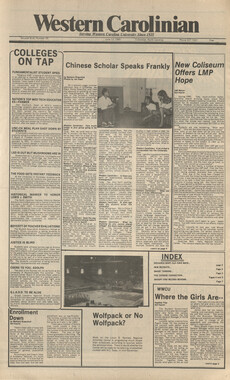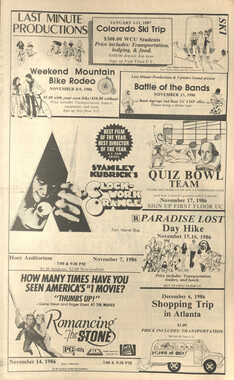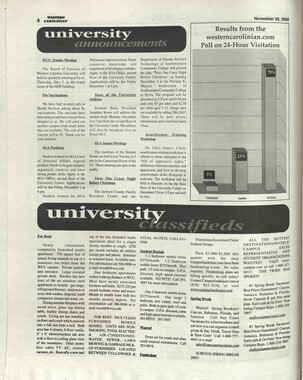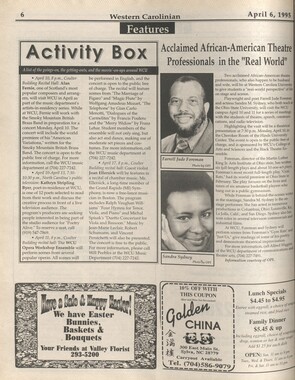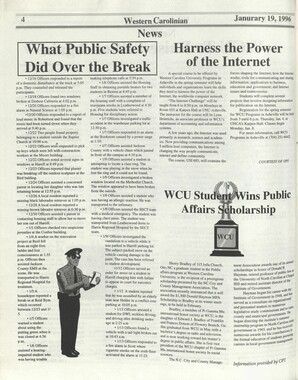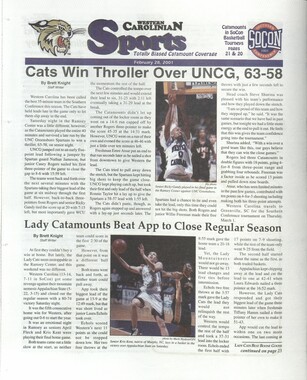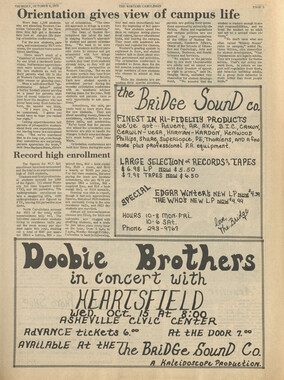Western Carolina University (21)
View all
- Canton Champion Fibre Company (2308)
- Cherokee Traditions (291)
- Civil War in Southern Appalachia (165)
- Craft Revival (1942)
- George Masa Collection (137)
- Great Smoky Mountains - A Park for America (3080)
- Highlights from Western Carolina University (422)
- Horace Kephart (998)
- Journeys Through Jackson (159)
- LGBTQIA+ Archive of Jackson County (90)
- Oral Histories of Western North Carolina (318)
- Picturing Appalachia (6617)
- Stories of Mountain Folk (413)
- Travel Western North Carolina (153)
- Western Carolina University Fine Art Museum Vitreograph Collection (129)
- Western Carolina University Herbarium (92)
- Western Carolina University: Making Memories (738)
- Western Carolina University Publications (2491)
- Western Carolina University Restricted Electronic Theses and Dissertations (146)
- Western North Carolina Regional Maps (71)
- World War II in Southern Appalachia (131)
University of North Carolina Asheville (6)
View all
- Allanstand Cottage Industries (62)
- Appalachian National Park Association (53)
- Bennett, Kelly, 1890-1974 (1463)
- Berry, Walter (76)
- Brasstown Carvers (40)
- Carver, George Washington, 1864?-1943 (26)
- Cathey, Joseph, 1803-1874 (1)
- Champion Fibre Company (233)
- Champion Paper and Fibre Company (297)
- Cherokee Indian Fair Association (16)
- Cherokee Language Program (22)
- Crowe, Amanda (40)
- Edmonston, Thomas Benton, 1842-1907 (7)
- Ensley, A. L. (Abraham Lincoln), 1865-1948 (275)
- Fromer, Irving Rhodes, 1913-1994 (70)
- George Butz (BFS 1907) (46)
- Goodrich, Frances Louisa (120)
- Grant, George Alexander, 1891-1964 (96)
- Heard, Marian Gladys (60)
- Kephart, Calvin, 1883-1969 (15)
- Kephart, Horace, 1862-1931 (313)
- Kephart, Laura, 1862-1954 (91)
- Laney, Gideon Thomas, 1889-1976 (439)
- Masa, George, 1881-1933 (61)
- McElhinney, William Julian, 1896-1953 (44)
- Niggli, Josephina, 1910-1983 (10)
- North Carolina Park Commission (105)
- Osborne, Kezia Stradley (9)
- Owens, Samuel Robert, 1918-1995 (11)
- Penland Weavers and Potters (36)
- Roberts, Vivienne (15)
- Roth, Albert, 1890-1974 (142)
- Schenck, Carl Alwin, 1868-1955 (1)
- Sherrill's Photography Studio (2565)
- Southern Highland Handicraft Guild (127)
- Southern Highlanders, Inc. (71)
- Stalcup, Jesse Bryson (46)
- Stearns, I. K. (213)
- Thompson, James Edward, 1880-1976 (226)
- United States. Indian Arts and Crafts Board (130)
- USFS (683)
- Vance, Zebulon Baird, 1830-1894 (1)
- Weaver, Zebulon, 1872-1948 (58)
- Western Carolina College (230)
- Western Carolina Teachers College (282)
- Western Carolina University (2008)
- Western Carolina University. Mountain Heritage Center (18)
- Whitman, Walt, 1819-1892 (10)
- Wilburn, Hiram Coleman, 1880-1967 (73)
- Williams, Isadora (3)
- Cain, Doreyl Ammons (0)
- Crittenden, Lorraine (0)
- Rhodes, Judy (0)
- Smith, Edward Clark (0)
- Appalachian Region, Southern (3032)
- Asheville (N.C.) (1945)
- Avery County (N.C.) (26)
- Blount County (Tenn.) (195)
- Buncombe County (N.C.) (1680)
- Cherokee County (N.C.) (283)
- Clay County (N.C.) (556)
- Graham County (N.C.) (238)
- Great Smoky Mountains National Park (N.C. and Tenn.) (535)
- Haywood County (N.C.) (3573)
- Henderson County (N.C.) (70)
- Jackson County (N.C.) (4926)
- Knox County (Tenn.) (35)
- Knoxville (Tenn.) (13)
- Lake Santeetlah (N.C.) (10)
- Macon County (N.C.) (421)
- Madison County (N.C.) (216)
- McDowell County (N.C.) (39)
- Mitchell County (N.C.) (135)
- Polk County (N.C.) (35)
- Qualla Boundary (982)
- Rutherford County (N.C.) (78)
- Swain County (N.C.) (2185)
- Transylvania County (N.C.) (270)
- Watauga County (N.C.) (12)
- Waynesville (N.C.) (86)
- Yancey County (N.C.) (72)
- Aerial Photographs (3)
- Aerial Views (60)
- Albums (books) (4)
- Articles (1)
- Artifacts (object Genre) (228)
- Bibliographies (1)
- Biography (general Genre) (2)
- Cards (information Artifacts) (38)
- Clippings (information Artifacts) (193)
- Copybooks (instructional Materials) (3)
- Crafts (art Genres) (622)
- Depictions (visual Works) (21)
- Design Drawings (1)
- Digital Moving Image Formats (2)
- Drawings (visual Works) (185)
- Envelopes (115)
- Exhibitions (events) (1)
- Facsimiles (reproductions) (1)
- Fiction (general Genre) (4)
- Financial Records (12)
- Fliers (printed Matter) (67)
- Glass Plate Negatives (381)
- Guidebooks (2)
- Internegatives (10)
- Interviews (823)
- Land Surveys (102)
- Letters (correspondence) (1070)
- Manuscripts (documents) (618)
- Maps (documents) (177)
- Memorandums (25)
- Minutes (administrative Records) (59)
- Negatives (photographs) (6090)
- Newsletters (1290)
- Newspapers (2)
- Notebooks (8)
- Occupation Currency (1)
- Paintings (visual Works) (1)
- Pen And Ink Drawings (1)
- Periodicals (194)
- Personal Narratives (10)
- Photographs (12977)
- Plans (maps) (1)
- Poetry (6)
- Portraits (4568)
- Postcards (329)
- Programs (documents) (181)
- Publications (documents) (2444)
- Questionnaires (65)
- Relief Prints (26)
- Sayings (literary Genre) (1)
- Scrapbooks (282)
- Sheet Music (2)
- Slides (photographs) (402)
- Songs (musical Compositions) (2)
- Sound Recordings (802)
- Specimens (92)
- Speeches (documents) (18)
- Tintypes (photographs) (8)
- Transcripts (329)
- Text Messages (0)
- A.L. Ensley Collection (275)
- Appalachian Industrial School Records (7)
- Appalachian National Park Association Records (336)
- Axley-Meroney Collection (2)
- Bayard Wootten Photograph Collection (20)
- Bethel Rural Community Organization Collection (7)
- Blumer Collection (5)
- C.W. Slagle Collection (20)
- Canton Area Historical Museum (2110)
- Carlos C. Campbell Collection (462)
- Cataloochee History Project (64)
- Cherokee Studies Collection (4)
- Daisy Dame Photograph Album (5)
- Daniel Boone VI Collection (1)
- Doris Ulmann Photograph Collection (112)
- Elizabeth H. Lasley Collection (1)
- Elizabeth Woolworth Szold Fleharty Collection (4)
- Frank Fry Collection (95)
- George Masa Collection (173)
- Gideon Laney Collection (452)
- Hazel Scarborough Collection (2)
- Hiram C. Wilburn Papers (28)
- Historic Photographs Collection (236)
- Horace Kephart Collection (861)
- Humbard Collection (33)
- Hunter and Weaver Families Collection (1)
- I. D. Blumenthal Collection (4)
- Isadora Williams Collection (4)
- Jesse Bryson Stalcup Collection (47)
- Jim Thompson Collection (224)
- John B. Battle Collection (7)
- John C. Campbell Folk School Records (80)
- John Parris Collection (6)
- Judaculla Rock project (2)
- Kelly Bennett Collection (1482)
- Love Family Papers (11)
- Major Wiley Parris Civil War Letters (3)
- Map Collection (12)
- McFee-Misemer Civil War Letters (34)
- Mountain Heritage Center Collection (4)
- Norburn - Robertson - Thomson Families Collection (44)
- Pauline Hood Collection (7)
- Pre-Guild Collection (2)
- Qualla Arts and Crafts Mutual Collection (12)
- R.A. Romanes Collection (681)
- Rosser H. Taylor Collection (1)
- Samuel Robert Owens Collection (94)
- Sara Madison Collection (144)
- Sherrill Studio Photo Collection (2558)
- Smoky Mountains Hiking Club Collection (616)
- Stories of Mountain Folk - Radio Programs (374)
- The Reporter, Western Carolina University (510)
- Venoy and Elizabeth Reed Collection (16)
- WCU Gender and Sexuality Oral History Project (36)
- WCU Mountain Heritage Center Oral Histories (25)
- WCU Oral History Collection - Mountain People, Mountain Lives (71)
- WCU Students Newspapers Collection (1923)
- Western North Carolina Tomorrow Black Oral History Project (69)
- William Williams Stringfield Collection (2)
- Zebulon Weaver Collection (109)
- African Americans (390)
- Appalachian Trail (35)
- Artisans (521)
- Cherokee art (84)
- Cherokee artists -- North Carolina (10)
- Cherokee language (21)
- Cherokee pottery (101)
- Cherokee women (208)
- Church buildings (190)
- Civilian Conservation Corps (U.S.) (111)
- College student newspapers and periodicals (2012)
- Dams (108)
- Dance (1023)
- Education (222)
- Floods (63)
- Folk music (1015)
- Forced removal, 1813-1903 (2)
- Forest conservation (220)
- Forests and forestry (1198)
- Gender nonconformity (4)
- Great Smoky Mountains National Park (N.C. and Tenn.) (181)
- Hunting (47)
- Landscape photography (25)
- Logging (122)
- Maps (83)
- Mines and mineral resources (9)
- North Carolina -- Maps (18)
- Paper industry (38)
- Postcards (255)
- Pottery (135)
- Railroad trains (72)
- Rural electrification -- North Carolina, Western (3)
- School integration -- Southern States (2)
- Segregation -- North Carolina, Western (5)
- Slavery (5)
- Sports (452)
- Storytelling (243)
- Waterfalls -- Great Smoky Mountains (N.C. and Tenn.) (66)
- Weaving -- Appalachian Region, Southern (280)
- Wood-carving -- Appalachian Region, Southern (328)
- World War, 1939-1945 (174)
Western Carolinian Volume 78 Number 07 (08)
Item
Item’s are ‘child’ level descriptions to ‘parent’ objects, (e.g. one page of a whole book).
-
-
The Western poral FEATURES Before They Were Educators: By Tyler Auffhammer News Editor Bones. We all have them. Some of us break ours and some of us have stronger ones. For a select few, bones make a career and are a. way of life. and passion. Among those few is Dr. : Cheryl Johnston, associ- ate professor of forensic anthropology at Western Carolina University. For Johnston, her first run-in with the field of forensic anthropology occurred when she a small child. While visit- - Ing relatives near Hen- dersonville Airport, she witnessed a plane crash that left debris from the plane and its passengers - falling from the sky and landing near their home. The experience didnt mess me up too bad. I just started asking my dad questions like, How are they going to iden- tify these people? and, How are they going to get these people back to their families? and he answered them for me. It was the point, now that I think about it, when I probably got interested in anthropology, said Johnston. ' Johnston cultivated - her interest in science by attending NC State as an undergraduate, double majoring in biol- - ogy and psychology. During her time at NC State, Johnston figured that she would conduct lab work after graduat- ing but found that she . did not enjoy killing rats all the time for her stud- ies. She knew that she could not suffer that for acareer. | - After graduating, Johnston could not find a job. Her husband . took a job with Battelle Memorial Institute, a private nonprofit applied science and technol- ogy development com- pany headquartered in Columbus, Ohio, so she began looking at gradu- ate schools in the area. With a big anthropol- ogy department at Ohio State University and a. newfound interest in the subject after taking an anthropology course -as asenior at NC State, Johnston began writing letters and calling the graduate school at OSU. After so many calls, the Ohio State told me that I should just stop ' by. I was accepted into the school soon after, and it taught me that if you want something, you need to show up in person, said Johnston. Johnston would go on to earn her masters degree from Ohio State and then took a full-time position working for the Ohio Historical Society. As a physical an- thropologist, I was put _ in charge of over 6,000 human remains. The Native American Graves Protection and Repatria- tion Act was recently passed at that time, and it was my job to cata- ~ logue them, said John- ston, who worked at the Ohio Historical Society for over nine years. Thanks to her new professional title earned | through working at the Historical Society, John- ston was able to take on some forensic cases in the area, where she saw any different stages of decomp and got her own CSI experience. She admitted that the television shows that fol- low crime scene inves- tigators are not exactly true to form, especially the dramatic lighting. ~ When really investi- gating in a forensic case, we need all the light we can get in our labs, so when the show portray a dimly lit lab for dramat- ic effect it isnt exactly true to real life, said Johnston. Johnston also began her Ph.D. coursework while still working at the Ohio Historical Soci- ety, pushed by her men- tor and co-worker, who had given up pursuing _ her Ph.D. and advised Johnston to not make the same mistake. _ Juggling her Ph.D. coursework and her job did not work for long. Johnston was forced to ' quit her job at the Ohio Historical Society when | it came time to com- plete her dissertation, as there was simply not enough time for both. After earning her Ph.D., Johnston began searching for her first teaching position in academia. After some positions with commu- nity colleges including Columbus State Com- munity Collegeas an ad- junct faculty, Johnston was hired for her first real teaching position at her alma mater, Ohio State, in their intro biol- ogy program. Thad a biology degree anda Ph.D. from a biol- ogy relevant discipline so the position with OSU was a natural fit. I developed labs and used some interesting and new pedagogy, which - was pushed heavily dur- ing my time there, said Johnston. Settling into her first tenure-track teaching position, Johnston was also in for some surpris- es. Standing up ina classroom all day was harder than I thought and my voice would go out from time to time, she explained. Howev- : er, I really liked seeing people get excited about things I like, even if I had to teach in lecture halls with more than 700 . students. After teaching at OSU for a year and a half, a position opened up at Western Carolina Uni- versity, which was look- ing for a director for its anthropology program. I didnt have enough experience for the posi- tion I applied for, but I wanted to be near the mountains again, said Johnston, who grew up in Asheville. After speaking on the phone a few times to the program director at that time, Johnston decided that showing up in per- son was the best option, a method that had given her good results when she applied to graduate school. Although she didnt receive the direc- tor position, another faculty position opened. up, and Johnston was hired. Now in her seventh year at Western Caro- lina University, John- ston has thoroughly enjoyed her time in - Cullowhee, where she now leads research and education at the Western Carolina Human Iden- tification Laboratory, a fully equipped facility August 24, 2012 A9 Dr. Cheryl Johnston Chapel. devoted to the es storage and analysis of human remains, the second of its kind in the nation. While the decomp center offers many research and education opportunities for faculty and students alike, it offers another bizarre prospect for Johnston: the chance to meet ~~ people who will eventu- ally donate their bodies to the Human Identifica- _ tion Lab. Tt never occurred to me during my stud- ies that I could meet _ the people that I would eventually be working on in skeletal form. I didnt feel prepared for it at first, said Johnston. . Johnston cites her great colleagues and students for allowing her the chance to follow success including jobs her interests and try , hew methods of teach- ing, hoping to step away from the lecture-based classes that she experi- enced in college. We have a good department where ev- erybody pulls together. There is never any fric- - tion between faculty and the students are great. The fact that WCU is f attracting students from all over is unusual, but ' they are motivated stu- dents, said Johnston. The career outlooks for Johnstons students are good, as many of her former students have gone on to have great with Joint POW/MIA Accounting Command, which identifies and re- patriates fallen soldiers... in places like Hawaii. Preparing to teach ee ( Photo by Scott Wallace/The Cherokee Scout r. Cheryl Johnston and John Williams, 4 WCU professor, look for Graves at Harshaw ~ classes this fall on top- : icsincludinghuman osteology and skeletal analyses, Johnston aa isalsoleadingafield + school class'this sum- ~* mer in which students ~ learn. how to system- atically remove a mock grave. -Inajob market like a ; today, many students ad G Pr ae : Las sey 2 are worried about their futures, but Johnston thinks otherwise, who found for herself a teaching position ina | similar job market after graduation but did so through her steadfast Dont listen to people | - who tell you that you | cant get a job. If theres | { { a f t i A { determination. 1 i i i Li i bi t something that you re- ally want to do and you } are determined to do it } and work hard, you can ' do it, said Johnston. Before They Were Educators: Jeanne Dulworth By Lex Menz: Co-Editor-in-Chief Jeanne Dulworth began as ajournalism > major at Western Caro- lina University. After an interview with her aca- demic adviser, however, she realized her per- sonality did not suit the field. Instead, she chose social work. Born in Brevard, Dul- worth was raised by two teachers, who instilled in her a lifelong desire to learn. When college time came, Dulworth chose Western Carolina for her bachelors degree pro- gram just like her older brother and some friends of the family. Tts almost like being at home, said Dulworth, who grew up in the North Carolina moun- tains. As a student, I wanted to absorb every- thing and have a good . time... All four years, Dul- worth lived in a dormi- tory, using the weekends - to hike, fish, camp, tube down the river, and she still does it today as a professor of WCU. As there were very few social work masters pro- grams in North Caroli- na, Dulworth traveled to the University of South . Carolina after graduat- ing from WCU. She said she wanted a larger school environment and was teetering with the idea of majoring in both social work and law. 4 T did not go there for the hot weather, added Dulworth. In 1998, Dulworth graduated with her mas- ters and jumped into the social work field. She worked in Brevard and Hendersonville at com- munity mental health centers, functioning as a case manager for children from birth to 18 with developmental and psychological disabili- ties, she said. Then, she progressed into the field of a family support spe- cialist with disabled kids from birth to five-years- old. She also counseled . the parents, who grieved heavily for their chil-: dren. Dulworth said that one of her most profound cases was a boy who was born without legs. Instead, his feet were - attached to his stomach. She said that they were beautiful baby feet, but she knew that eventu- ally they would need to be amputated when he began to grow. Other cases involved several autistic children who bit their parents out of frustration of being unable to communicate. Dulworth was moved by the parents, especially when they came full cir- cle from wondering why God was cursing them to being thankful God had chosen them to raise a child with disabilities. T got to see the strength of people in incredibly difficult situ- ations, and that was just a gift to me, said Dul- worth. Dulworth decided she wanted to move into the teaching field soon after graduating from the Uni- versity of South Caroli- - na. There was an open- ing at Western Carolina, and after two semesters . _of teaching night classes, Dulworth became a full- time professor in 2000. She credited the social work department head, Dr. Terry Gibson, with inspiring her.. She definitely was instrumental for me in finding a passion for social work education, - Dulworth said. Dulworth has a nate faceted teaching phi- losophy that encumbers much of what her par- ents taught her, includ- ing that reaching each individual and finding what makes them special is important. She is also a big fan of service learning because itis a win-win situation. T believe that students have as much to offer as their faculty, said Dulworth. That we as faculty have to come up with questions for them to think about critically and make their own conclusions. I believe that learning is a lifelong process and good teach- ers continue to learn every day. While teaching, Dul- worth still volunteers % with hospice. Most of my clients were kids that were _ dying, Dulworth said. The kids were great. Every one of them seemed to take it with such grace. It reminds me that life is precious. Dulworth also works with pregnant teenag- ers. She helps them with nutritional needs, boost- ing their self esteem and even filling in as a coach during the birth. That taught me not to be judgmental. Most of the girls on my case load were raped or the baby was conceived through | said Dulworth. incest.. adding that the experi- ence taught mea whole lot about how you never know anyones story until they share it with you. The next chapter of Dulworths teaching begins in the recently opened Health and Hu- man Sciences building on WCUs West Campus. She is excited about the new building with its phenomenal technol- ogy and having the two programs together in order that students will get that full perspec- tive. Teaching here at Western is one of the greatest honors of my life, said Dulworth. I feel so blessed to be around inspiring faculty working to change and touch the lives of stu- dents. New route WCU News Services There is a hew driver behind the wheel this - semester when the bus pulls up to transport Western Carolina Uni- and staff to and from off-campus housing. ing and transportation services office has as- running an off-campus shuttle service previ- ously provided by Jack- campus transportation, which began with the. 2007 fall semester, now falls under the auspices of WCUs University Police Department and transportation system. much will change for the students and other riders, said Police Chief Earnest Hudson. Our Cat-Tran buses = campus housing com- Two routes will be maintained, witha round trip-time of 30 minutes. The north route, which includes University Suites, Sleepy Hollow and the Maples, will leave from A.K. Hinds University at 3:30 p.m. The south route, which includes a versity students, faculty The universitys park- sumed responsibility for son County Transit. Off its Cat-Tran on-campus Other than the look and color of the bus, not basically will be follow- ing the same routes and stopping at the same off- plexes as in past years. Center at 7:30 a.m., 9:30 - a.m., 11:30 a.m. and 1:30 p.m., with the final run Campus Apartments, Laurel Oaks, Hampton/ ; Rabbit Ridge, Summit and Catamount Peaks, will leave the Univer- sity Center at every half hour from 8 a.m. until 4 p.m., except for those times the shuttle will be | heading for the north route. This works out to a ratio of three trips to the more populous south route for every one trip on the north route, Hudson said. WCU students, faculty and staff may ride free of charge by showing ~ their WCU identifica- . tion cards. Also, over the sum- mer, Cat-Tran staff . members installed new signs for the on-campus ~ shuttles, reducing the total number of official stops to 20. Buses will make pick-ups and drop-offs only at speci- fied locations. During peak hours, three shuttles will be serving the main cam- pus, and they typically will run 10 minutes apart. Cat-Tran also will continue to main- tain the Village ex- press during the morn- | ing and early afternoon | hours, transporting ' students to and from the Village on-campus residential complex. A very concerted ef- fort is being made to be as efficient and timely as possible, said Don Taylor, Cat-Tran man- ager. for Cattran ee #2 a8
Object
Object’s are ‘parent’ level descriptions to ‘children’ items, (e.g. a book with pages).
-
The Western Carolinian is Western Carolina University's student-run newspaper. The paper was published as the Cullowhee Yodel from 1924 to 1931 before changing its name to The Western Carolinian in 1933.
-

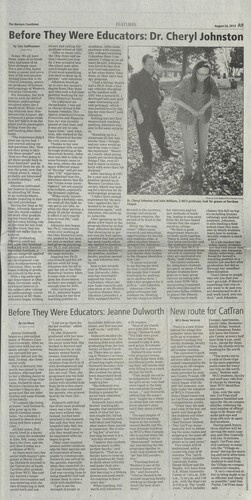
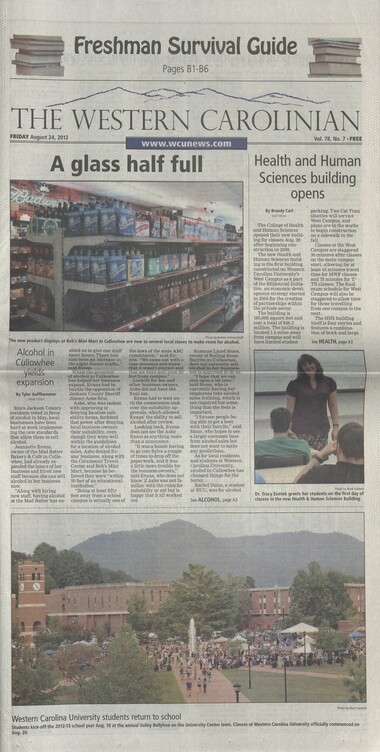
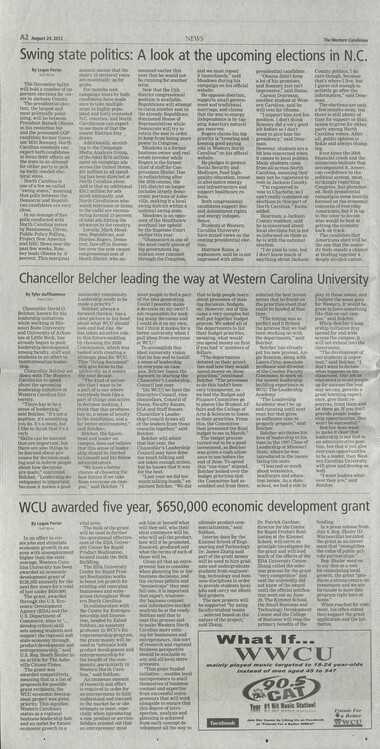
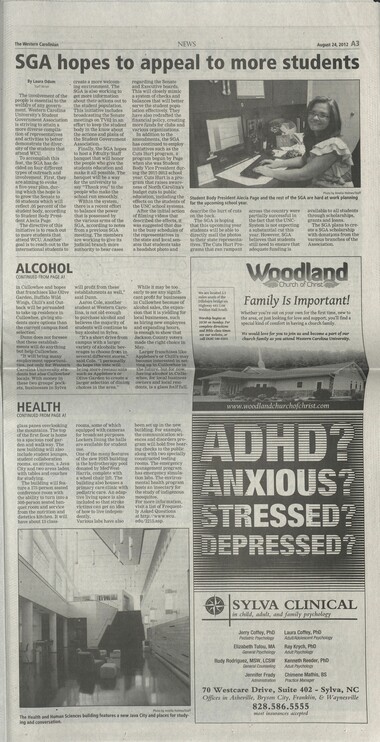
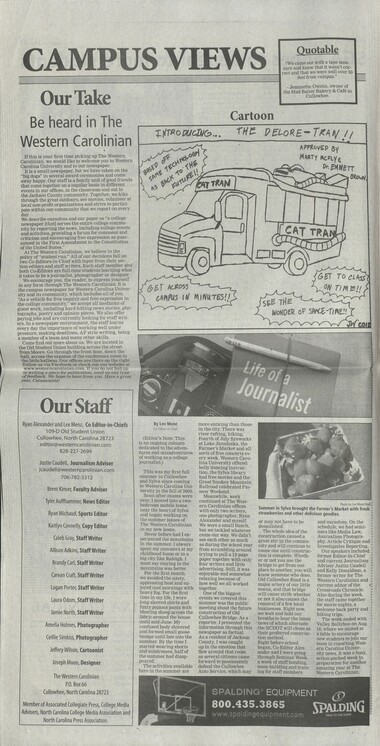
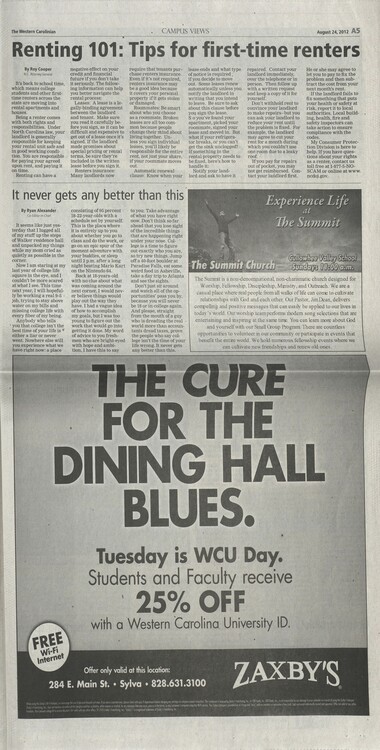
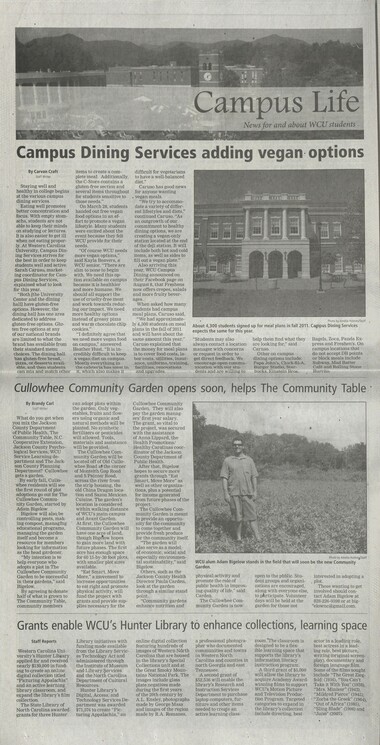

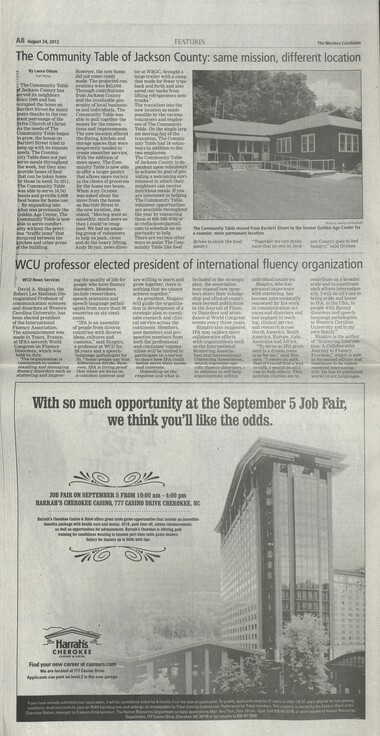



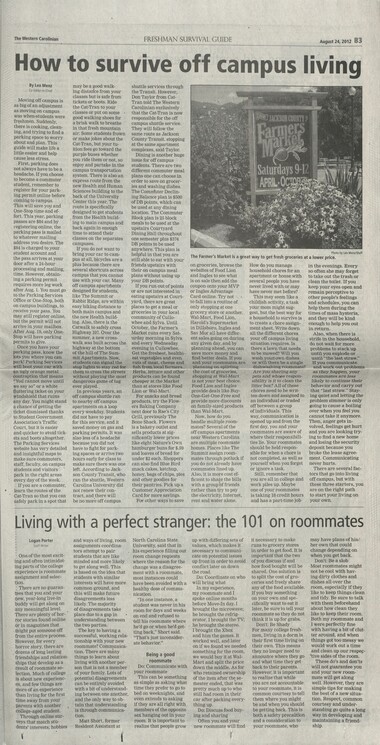
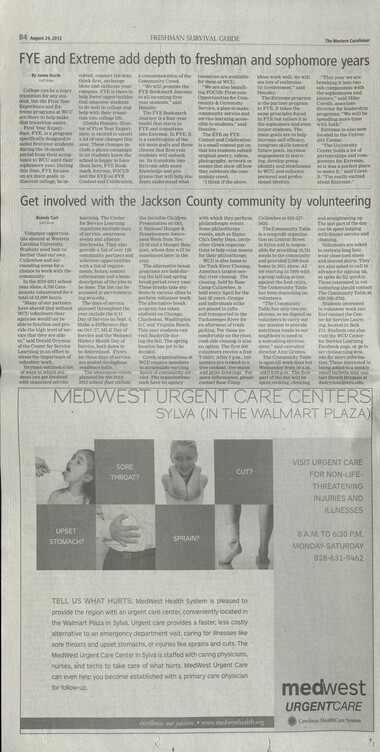

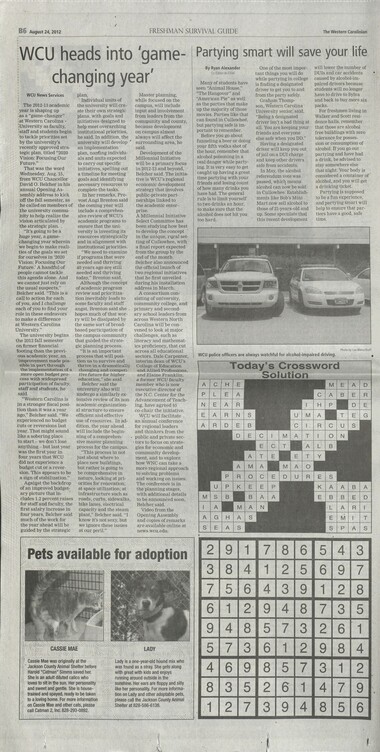
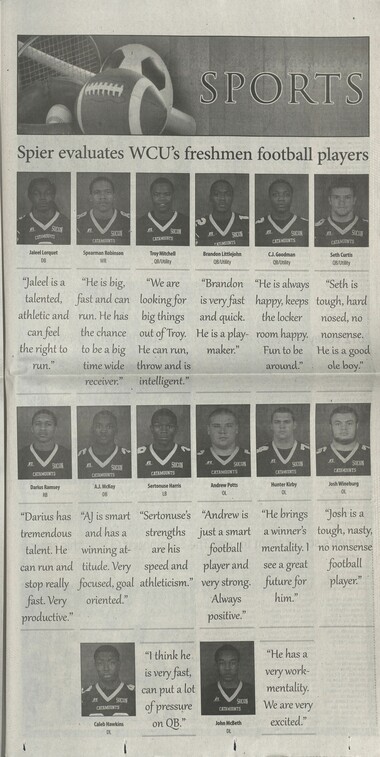
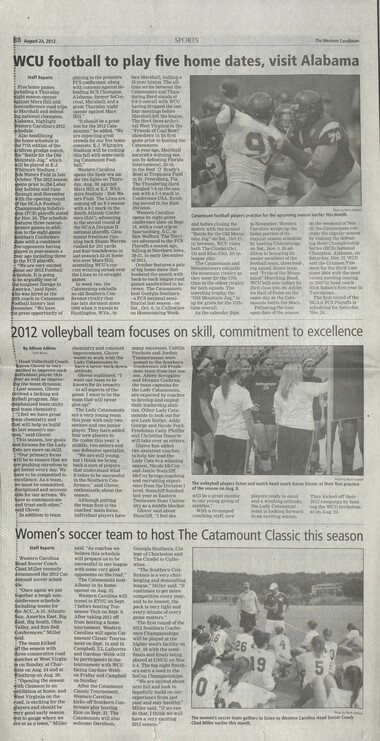
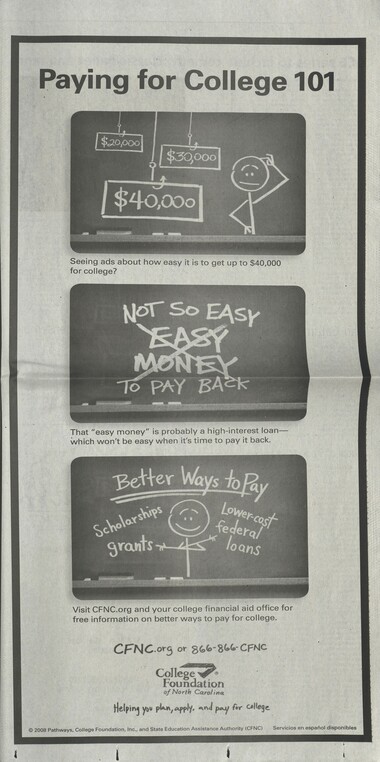
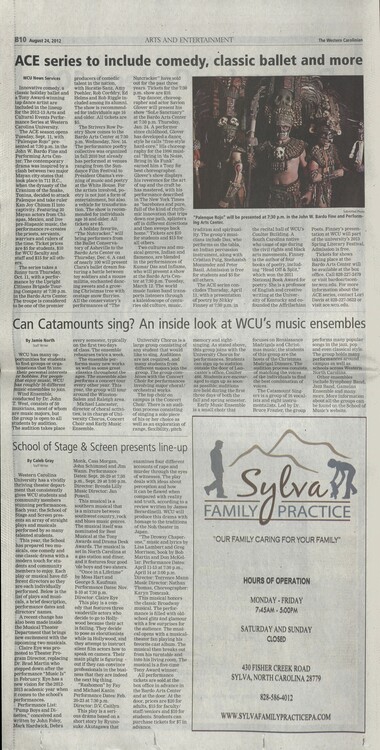

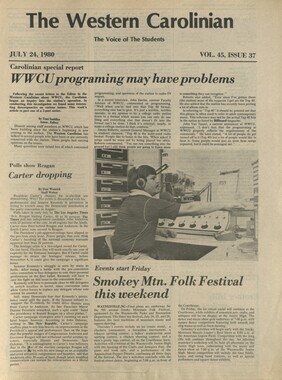


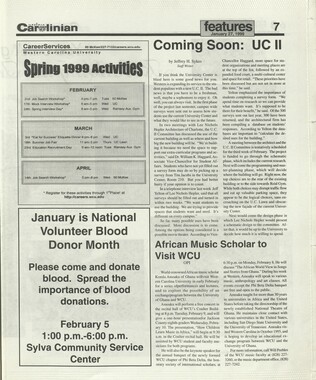
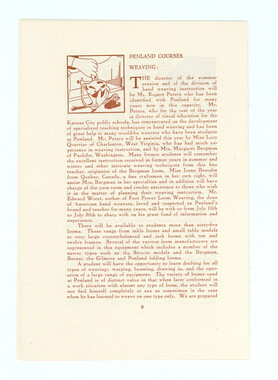
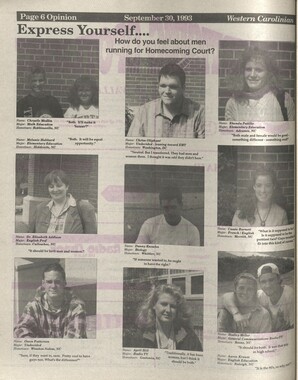

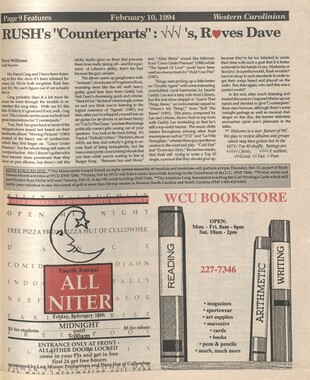
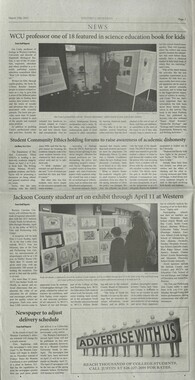
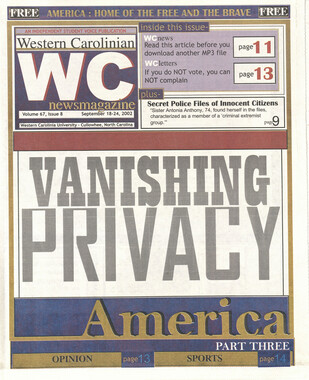
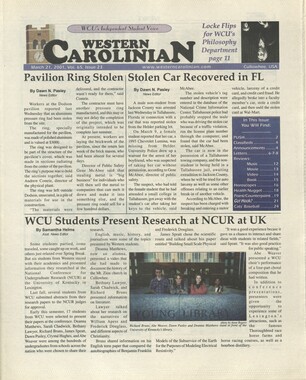
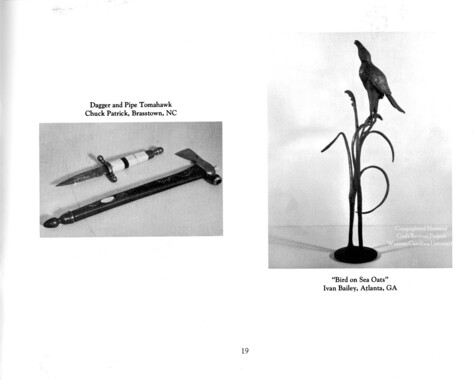
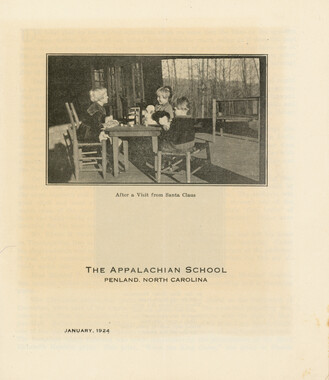
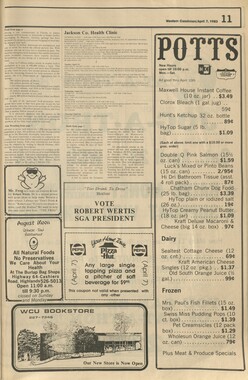
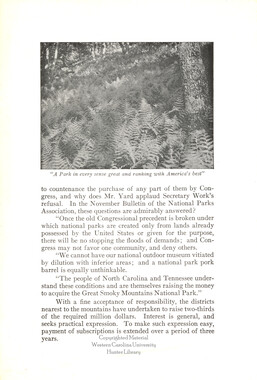
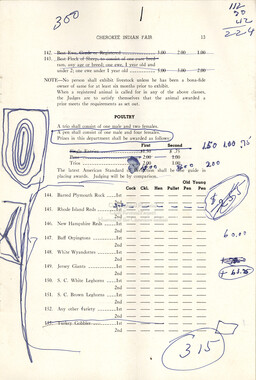

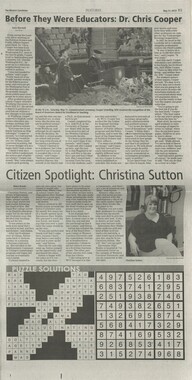
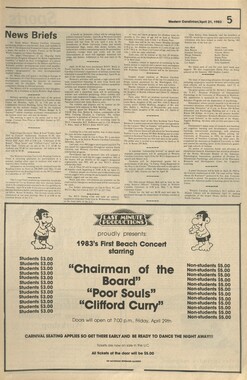
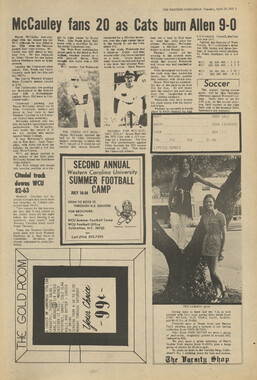
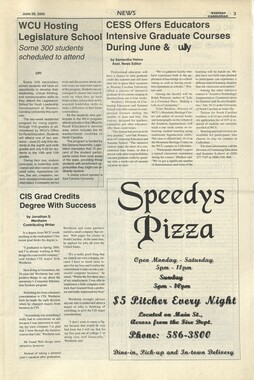
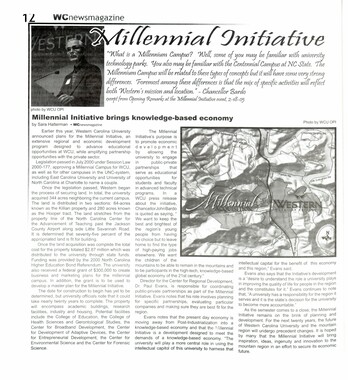
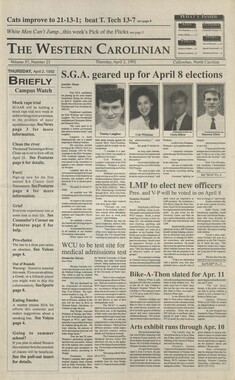
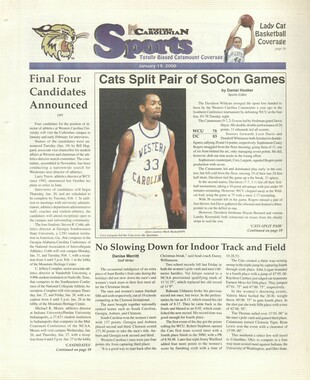
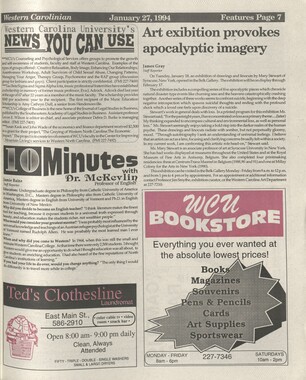
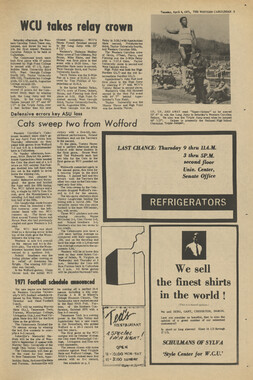
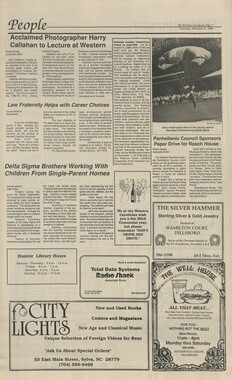
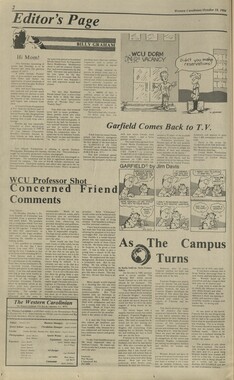
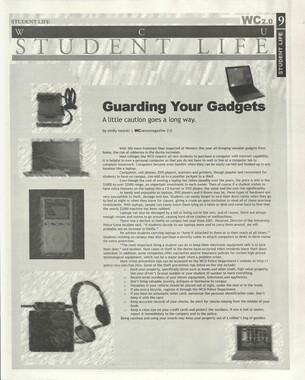

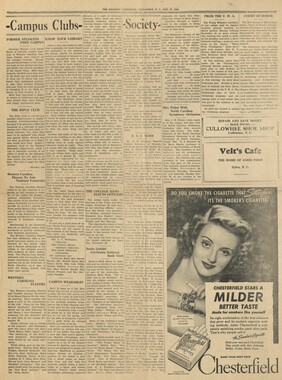
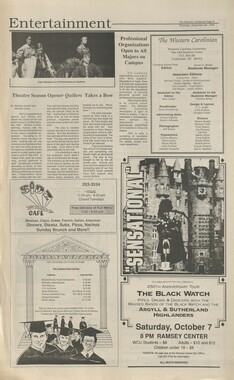


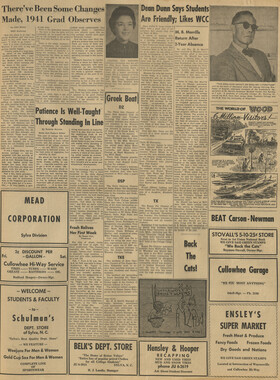
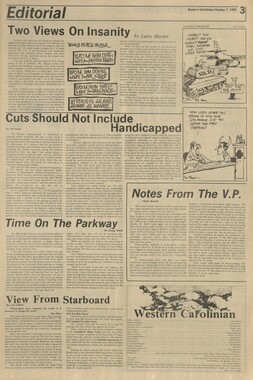
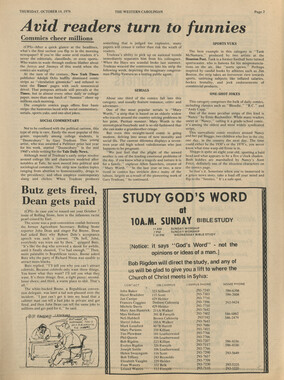


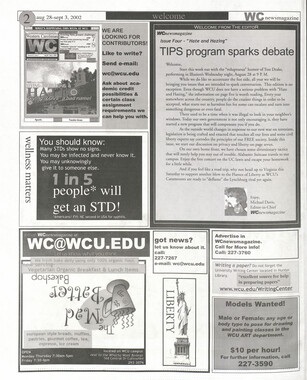
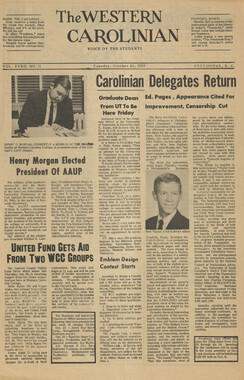
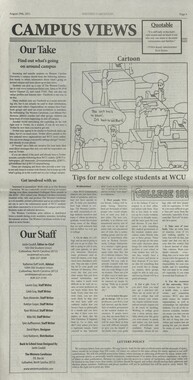

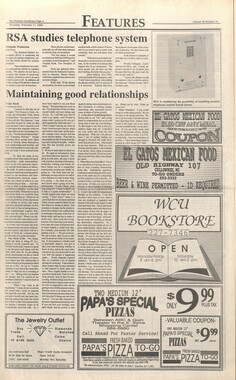
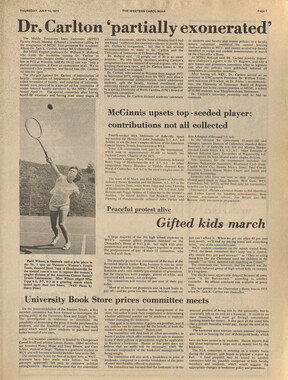


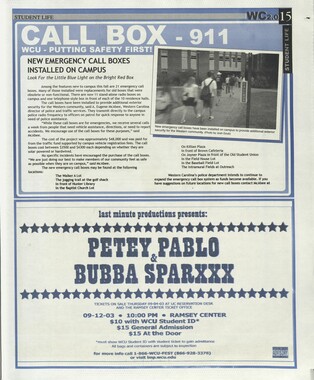
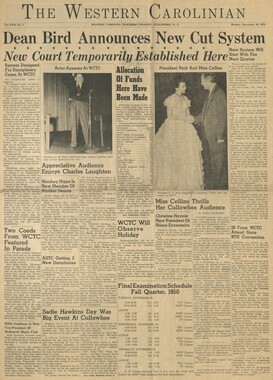
![hl_westerncarolinian_2008-09-26[10-27]_vol74_no03[04]_16.jpg](/media/w400h300/wcu_publications/hl_westerncarolinian_2008-09-26[10-27]_vol74_no03[04]_16.jpg)

